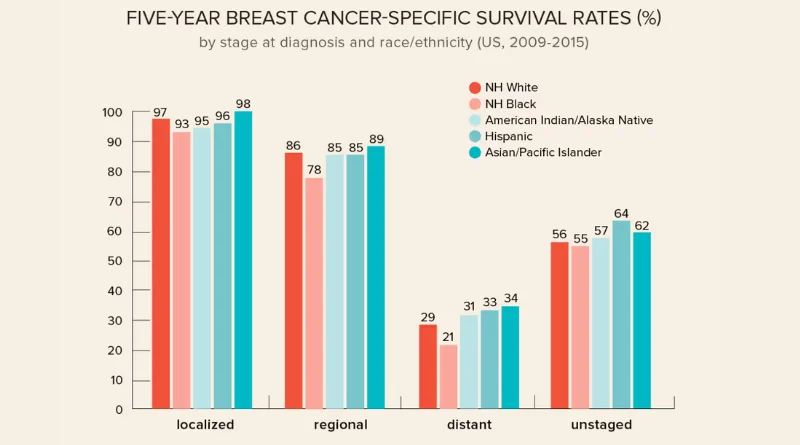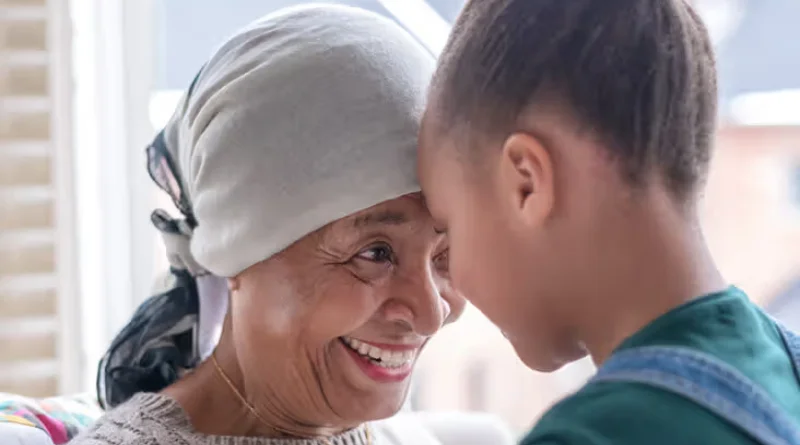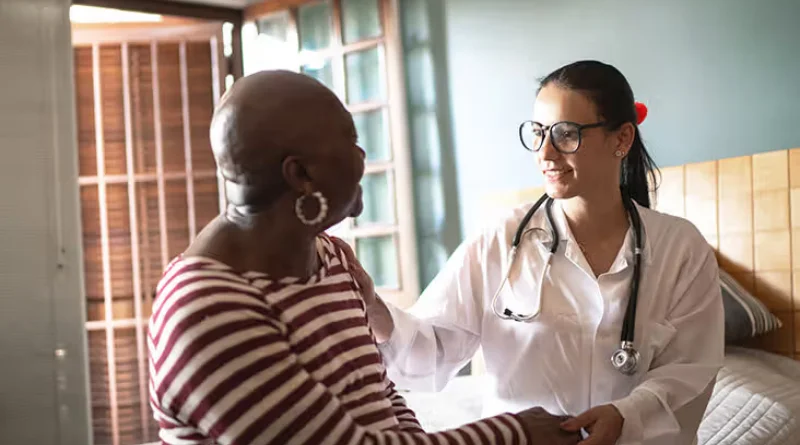Stage 3 Breast Cancer: Recognizing Your Outlook
Definition of Stage 3 Breast Cancer
Breast cancer, when diagnosed, is classified into different stages to determine the extent of its spread. Stage 3 breast cancer represents an advanced stage where the disease has progressed beyond the breast and nearby lymph nodes. At this point, the cancer may have invaded surrounding tissues, increasing the complexity of treatment and impacting the overall prognosis.
Importance of Understanding the Outlook
Understanding the outlook of Stage 3 breast cancer is crucial for patients, their families, and healthcare professionals alike. It provides insights into the severity of the condition, influences treatment decisions, and helps individuals prepare for the challenges that lie ahead. By comprehending the implications of a Stage 3 diagnosis, individuals can actively engage in their treatment journey, making informed decisions to improve their chances of a positive outcome.
Overview of the Article
In this article, we delve into the multifaceted aspects of Stage 3 breast cancer, aiming to empower readers with knowledge and insights. From the characteristics and diagnosis of Stage 3 breast cancer to the available treatment options and their potential side effects, this comprehensive guide will navigate readers through the complexities of the disease. Furthermore, we explore the emotional and psychological impact, discuss lifestyle changes for better outcomes, and provide valuable information on ongoing care and survivorship.
Embark on this informative journey to gain a deeper understanding of Stage 3 breast cancer, discover inspiring patient stories, and find practical guidance on coping with the challenges associated with this advanced stage of the disease. Together, let’s navigate the intricacies of Stage 3 breast cancer with knowledge, resilience, and hope.
Understanding Stage 3 Breast Cancer

Navigating the complexities of Stage 3 breast cancer requires a grasp of its intricacies. Imagine it as a pivotal chapter in the breast cancer story, where the plot thickens, and the narrative becomes more nuanced. To embark on this journey, let’s break down the stage into three key aspects, ensuring you’re equipped with the knowledge needed to face this formidable foe head-on.
Explanation of Breast Cancer Staging
Unraveling the mystery of breast cancer staging is like decoding the language of your body’s battle against the disease. Staging involves assessing the size of the tumor, its spread to nearby tissues, and whether cancer cells have invaded the lymph nodes. Think of it as the road map to understanding the battlefield, helping doctors tailor a treatment plan that best suits your unique situation.
Characteristics of Stage 3 Breast Cancer
- Tumor Size: In Stage 3, the tumor is often larger and may extend to nearby tissues.
- Lymph Node Involvement: Cancer cells may infiltrate nearby lymph nodes.
- Tissue Invasion: The cancer might invade the chest wall or skin, making treatment more challenging.
Factors Influencing Prognosis
Consider prognosis as the crystal ball that predicts the future of your battle. Factors such as the tumor size, the extent of lymph node involvement, and the responsiveness to treatment play a pivotal role. Understanding these influences empowers you to actively engage in your treatment, making informed decisions to tip the scales in favor of a positive outcome.
Diagnosis and Detection
Embarking on the journey of diagnosis and detection in the realm of breast cancer is akin to unveiling the mystery within. Think of it as a quest for answers, where medical detectives employ a range of tools to decipher the subtle clues left by the elusive culprit of cancer. In this section, we’ll delve into the detective work of medical professionals, the significance of early detection, and the crucial role each diagnostic method plays in revealing the story of breast cancer.
A. Methods of Diagnosis
Unveiling the secrets of breast cancer involves deploying a strategic arsenal of diagnostic methods, each with its unique prowess. Mammograms, the stealthy scouts of early detection, use low-dose X-rays to capture images of breast tissue, exposing any suspicious masses. Biopsies, the forensic experts in this investigative team, involve extracting tissue samples for microscopic examination, providing a definitive diagnosis. Together, these diagnostic tools form a dynamic duo, shedding light on the nature and extent of the cancerous intruder.
B. Importance of Early Detection
In the grand saga of breast cancer, early detection emerges as the hero that can alter the course of the narrative. Picture it as the difference between catching a villain in the act versus after the crime has unfolded. Detecting breast cancer in its early stages significantly enhances treatment success rates, offering a higher probability of complete recovery. The earlier the diagnosis, the more treatment options are available, emphasizing the crucial role of regular screenings and heightened awareness in the fight against breast cancer.
C. Role of Medical Professionals in Diagnosis
| Medical Professional | Role in Diagnosis |
|---|---|
| Radiologist | Analyzes mammogram results, identifying potential abnormalities. |
| Pathologist | Examines biopsy samples, providing a definitive diagnosis based on tissue analysis. |
| Oncologist | Develops and oversees the treatment plan, considering the diagnostic findings and patient-specific factors. |
| Surgeon | Performs biopsy procedures and surgical interventions based on diagnostic results. |
Treatment Options
Embarking on the battlefield against breast cancer introduces a variety of treatment options, each donning its unique armor to combat the adversary. Picture it as assembling a superhero team, where surgery, chemotherapy, radiation therapy, and hormone therapy take center stage. Together, they form a formidable alliance, tailoring their powers to the specific needs of each patient’s quest for recovery.
A. Overview of Treatment Modalities
In the grand spectacle of breast cancer treatment, various modalities come into play, each with its superheroic abilities. Surgery, the frontline warrior, removes tumors and cancerous tissue with precision. Chemotherapy, the versatile mage, employs powerful drugs to eradicate cancer cells throughout the body. Radiation therapy, the targeted archer, aims precision beams at cancer sites, neutralizing the threat. Hormone therapy, the strategic tactician, interferes with hormone-driven cancers, disrupting their growth. This dynamic quartet forms the backbone of breast cancer treatment, and their synergistic efforts pave the way for triumph against the disease.
1. Surgery
Surgery, the valiant knight in the breast cancer crusade, takes center stage by removing tumors and affected tissues. Whether through lumpectomy, removing the tumor and a small surrounding margin, or mastectomy, eliminating the entire breast, surgical interventions play a pivotal role in curbing the spread of the adversary.
2. Chemotherapy
Chemotherapy, the potent magician in the arsenal, employs a cocktail of drugs to eliminate cancer cells throughout the body. Administered intravenously or orally, these drugs disrupt the rapid growth of cancer cells, but their mighty impact may come with temporary side effects like nausea, fatigue, and hair loss.
3. Radiation Therapy
Radiation therapy, the precision archer, delivers focused beams of radiation to targeted cancer sites, preventing the unbridled growth of malignant cells. Like a skilled marksman, radiation therapy minimizes damage to surrounding healthy tissue while ensuring the eradication of cancer cells.
4. Hormone Therapy
Hormone therapy, the strategic tactician, addresses hormone receptor-positive breast cancers. By blocking or inhibiting hormone production, this treatment disrupts the fuel source for certain types of breast cancer, hindering their growth and reducing the risk of recurrence.
B. Personalized Treatment Plans
- Tailored combinations of surgery, chemotherapy, radiation therapy, and hormone therapy.
- Consideration of individual cancer characteristics and patient preferences.
- Ongoing adjustments based on treatment response and evolving medical insights.
C. Side Effects and Coping Strategies
| Treatment Modality | Common Side Effects | Coping Strategies |
|---|---|---|
| Surgery | Pain, swelling, limited mobility | Physical therapy, pain management, emotional support |
| Chemotherapy | Nausea, fatigue, hair loss, immune suppression | Anti-nausea medications, supportive care, wig alternatives |
| Radiation Therapy | Skin irritation, fatigue | Topical treatments, rest, skincare routines |
| Hormone Therapy | Hot flashes, mood swings | Lifestyle adjustments, counseling, hormonal support |
Prognosis and Survival Rates
In the gripping saga of breast cancer, understanding the prognosis and survival rates is like deciphering the story’s climax. Picture it as a compass guiding you through the twists and turns of your journey, helping you anticipate challenges and celebrate victories. Let’s explore the factors shaping the prognosis. Peek into the statistical tapestry of survival rates, and uncover the significance of ongoing medical monitoring.
A. Factors Influencing Prognosis
The crystal ball of breast cancer prognosis is influenced by a myriad of factors, each playing a role in predicting the outcome of the battle. Tumor size, lymph node involvement, the tumor’s molecular characteristics, and the response to treatment dance together in determining the narrative’s direction. By understanding these factors, individuals can actively engage in their quest for survival. Making informed decisions to tilt the odds in their favor.
B. Statistics on Survival Rates

| Stage of Breast Cancer | 5-Year Survival Rate |
|---|---|
| Stage 3 | Varied, depending on specific characteristics and response to treatment survival rate is 70–86%. |
C. Importance of Ongoing Medical Monitoring
- Early Detection of Recurrence: Regular check-ups and screenings facilitate the timely identification of any potential recurrence.
- Adjusting Treatment Plans: Ongoing monitoring allows healthcare professionals to make real-time adjustments to treatment strategies based on the body’s response and changing circumstances.
- Emotional Support: Consistent medical monitoring provides a support system, offering reassurance and guidance throughout the survivorship journey.
Ongoing medical monitoring acts as a vigilant guardian in the realm of breast cancer, ensuring that individuals continue their journey with a proactive and empowered approach.
Emotional and Psychological Impact
Embarking on the emotional terrain of breast cancer is akin to navigating a rollercoaster of feelings. Picture it as a wild ride with highs and lows, where understanding the emotional and psychological impact becomes a crucial aspect of the journey. Let’s explore coping mechanisms, and support systems. And mental health considerations that equip individuals and their loved ones for the twists and turns ahead.
A. Coping with the Diagnosis
Receiving a breast cancer diagnosis can feel like a seismic shift, shaking the very foundations of one’s world. Coping with this news involves a blend of resilience, acceptance, and seeking solace in support networks. From expressing emotions openly to exploring therapy options, finding personalized coping strategies becomes the compass that guides individuals through the emotional landscape of their breast cancer journey.
B. Support Systems for Patients and Their Families
Imagine building a fortress of emotional support, where patients and their families stand united against the challenges of breast cancer. Whether it’s through the warmth of family bonds, the understanding ear of friends, or the professional guidance of support groups, a robust support system becomes the bedrock of emotional well-being. Encouraging open communication and seeking assistance when needed creates a network that weathers the emotional storms, fostering resilience and strength.
C. Mental Health Considerations During Treatment
| Mental Health Consideration | Strategies for Support |
|---|---|
| Anxiety and Stress | Meditation, mindfulness, counseling, and stress management |
| Depression | Psychotherapy, support groups, and medication when necessary |
| Body Image Concerns | Counseling, support groups, and embracing self-love |
Patient Stories and Inspiration

Embarking on the quest against Stage 3 breast cancer is a unique journey, and the tales of those who have walked this path before become beacons of inspiration. Picture it as a gathering around a campfire, where real-life experiences illuminate the darkness, offering comfort, insight, and a shared sense of camaraderie. Let’s delve into the narratives of individuals who have faced Stage 3 breast cancer, exploring the challenges, victories, and the wellspring of hope that emerges from their stories.
A. Real-Life Experiences of Individuals with Stage 3 Breast Cancer
In the tapestry of Stage 3 breast cancer, real-life stories are woven with threads of resilience, courage, and determination. These narratives share the diverse ways individuals confront the challenges of diagnosis, treatment, and survivorship. From the initial shock to the triumphs over adversity, these personal accounts provide a profound insight into the unique and shared aspects of the Stage 3 breast cancer journey. Offering a beacon of understanding for those treading similar paths.
B. Overcoming Challenges and Finding Hope
- Resilience in Adversity: Stories highlight the strength that emerges from facing adversity head-on.
- Navigating Treatment Hurdles: Insights into how individuals overcome treatment challenges, fostering hope for others.
- Celebrating Milestones: Victories, no matter how small, become beacons of hope, showcasing the possibility of triumph over challenges.
C. Encouragement for Those Facing a Similar Journey
To those embarking on the challenging voyage of Stage 3 breast cancer, take solace in the stories of those who have gone before you. Their tales not only provide insights into the challenges you may encounter but also underscore the triumphs and resilience that can define your journey. Know that you are not alone and in the narratives of others. You may find strength, inspiration, and the unwavering hope that propels you forward. The journey may be arduous, but the stories of triumph over adversity remind us that every step forward is a victory worth celebrating.
Conclusion
In the riveting exploration of Stage 3 breast cancer. We’ve navigated the complex landscape from diagnosis to survivorship, shedding light on crucial aspects of understanding, treatment, and emotional resilience. Picture this journey as an epic adventure. Where the hero, armed with knowledge and support, faces the challenges of an advanced-stage diagnosis with courage and determination. Let’s gather around the campfire one last time. Summarizing the key insights and empowering you to chart your course through the realm of Stage 3 breast cancer.
A. Recap of Key Points
| Topic | Key Insights |
|---|---|
| Breast Cancer Staging | Understanding the stage sets the foundation for treatment. |
| Diagnosis and Detection | Early detection through methods like mammograms is crucial. |
| Treatment Options | Surgery, chemotherapy, radiation, and hormone therapy form the core treatment modalities. |
| Prognosis and Survival Rates | Factors like tumor size and treatment response influence outcomes. |
| Emotional and Psychological Impact | Coping strategies and support systems are vital for emotional well-being. |
| Patient Stories and Inspiration | Real-life experiences inspire and share camaraderie. |
B. Empowering Individuals to Understand and Navigate Their Diagnosis
In this grand saga, understanding your diagnosis emerges as the magical key to unlocking the potential for a triumphant journey. Armed with knowledge about staging, diagnostic methods, treatment options, and the emotional terrain, you become the protagonist of your own story. The stories of those who have walked similar paths serve as lanterns. Lighting the way, and the support systems around you become the trusted allies in the battle against Stage 3 breast cancer. As you embark on this adventure, remember that knowledge is your armor, and the community surrounding you is your steadfast shield. With resilience, hope, and a network of support, you possess the tools to not only face but conquer the challenges that come your way. This is your journey embrace it, navigate it, and emerge victorious.
FAQS:
How Serious is Stage 3 Breast Cancer?
Wondering about the seriousness of stage 3 breast cancer? While we all crave some stats for a sneak peek into the future, it’s important to remember that numbers don’t reveal the entire adventure. Your unique breast cancer type, overall health, and a bunch of other factors can spice things up. Having a heart-to-heart with your healthcare squad is like unlocking a treasure chest of insights, helping you map out your cancer journey with style.
Is Stage 3 Breast Cancer a Game-Ender?
Is stage 3 breast cancer a terminal twist in the plot? Well, it’s a bit like asking if your favorite show ends with a cliffhanger – it depends. The subtype of your cancer and whether the tumor is playing hide-and-seek or not determine the game’s outcome. The good news? At this stage, you’ve got more treatment options than a menu at a fancy restaurant. So, chin up – you’ve got a whole arsenal to tackle this level.
What’s the Scoop on Breast Cancer’s Lymph Node Adventure?
When breast cancer decides to explore the lymph nodes, is it a wild, untamed adventure? It might sound like a plot twist, but it could be classified as stage 3 or regional cancer. The classification dance might tweak those 5-year survival rates a bit, but we’re talking somewhere between 70-86%. Think of it like navigating a rollercoaster with twists and turns – a mix of uncertainty and hope.
Also Read: Practicable Complications of Advanced Breast Cancer Journey
“As we conclude this mrprecious journey, immerse yourself in the latest Mr precious wonders across tech, Gemstones, sports, Cars, Quotes, and health. From groundbreaking tech trends to captivating, thrilling sports moments, and essential health insights, Mr preciousis your ultimate destination. So, until our next Mr precious update, stay mrprecious. Stay engaged, and keep thriving in the dynamic world of Mr precious innovations!”

